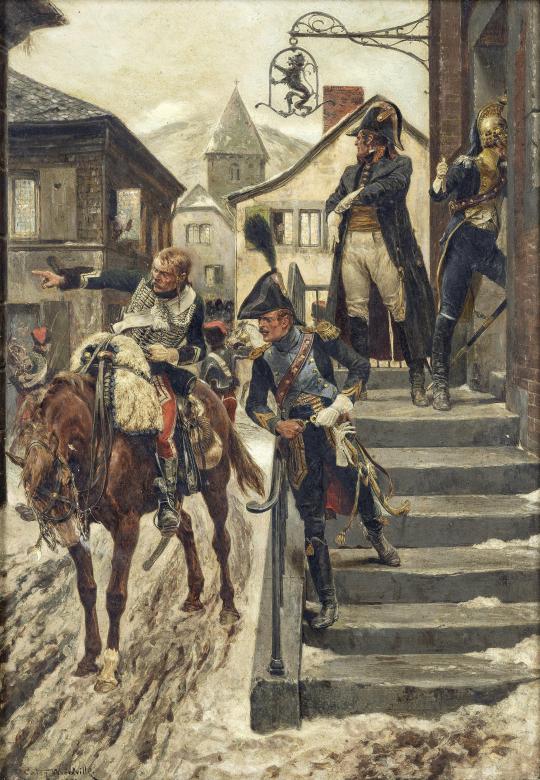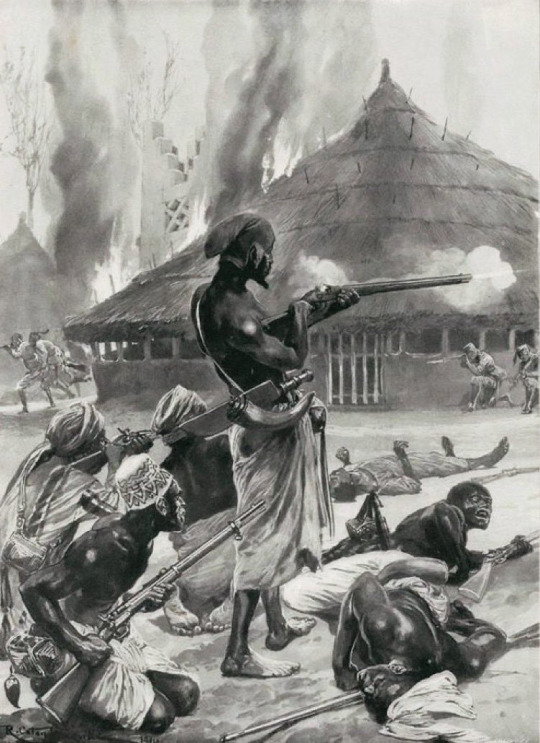#Richard Caton Woodville
Explore tagged Tumblr posts
Photo

Richard Caton Woodville - self-portrait
182 notes
·
View notes
Text
07 Paintings, The Battle of Arsūf, on September 7th., The Bloodiest Day of the Third Crusade, Richard I and Saladin at the Battle of Arsuf
Glyn Warren Philpot (1884–1937)Richard I Leaving England for the Crusades, 1189, c. 1925–1927Oil on canvasH 304.8 x W 442 cmParliamentary Art Collection The Battle of Arsuf took place on 7 September 1191, as part of the Third Crusade. It saw a multi-national force of Crusaders, led by Richard I of England, defeat a significantly larger army of the Ayyubid Sultanate, led by Saladin… Please…

View On WordPress
#Arthistory#Artists#Biography#Eloi Firmin Feron#fineart#footnotes#History#James William Glass#Paintings#Richard Caton Woodville#Théodore Lambert Antoine#Zaidan
2 notes
·
View notes
Text

the charge of the light brigade by richard caton woodville (1894)
2 notes
·
View notes
Text

Self Portrait with Flowered Wallpaper (ca1849) by Richard Caton Woodville
6 notes
·
View notes
Text
The Scout reports.

French Napoleonic soldiers receiving intelligence by Richard Caton Woodville Jr.
262 notes
·
View notes
Text

Christmas in the Backwoods: Absent Friends, by Richard Caton Woodville Jr. Lithograph, 1902.
#richard caton woodville jr.#vintage illustration#christmas#vintage christmas#cosy#black and white#Christmas in the Backwoods: Absent Friends
8 notes
·
View notes
Text

The Wounded Pipers Gallantry by Richard Caton Woodville, showing the storming of Dargai Heights by the 1st Gordon Highlanders.
119 notes
·
View notes
Text

Richard Caton Woodville, the 5th Lancers re-enter Mons, November 1918. The 5th were the last to leave Mons in 1914, and they were the first to enter it in 1918.
10 notes
·
View notes
Photo
Crowning the Userper on Bosworth Field

King Henry VII crowned after the Battle of Bosworth Field on 22nd August 1485.
Illustration author: Richard Caton Woodville
138 notes
·
View notes
Text

El propio diablo, 1908 (The Devil's Own, 1908 )
Richard Caton Woodville
11 notes
·
View notes
Text

Cleopatra, by Richard Caton Woodville, 1889.
16 notes
·
View notes
Text

Aro Confederacy
The Aro Confederacy (1690–1902) was a political union orchestrated by the Aro people, Igbo subgroup, centered in Arochukwu in present-day southeastern Nigeria. The Aro Confederacy kingdom was founded after the beginning of the Aro-Ibibio Wars. Their influence and presence was all over Eastern Nigeria, lower Middle Belt, and parts of present-day Cameroon and Equatorial Guinea during the 18th and 19th centuries. The Arochukwu Kingdom was an economic, political, and an oracular center as it was home of the Ibini Ukpabi oracle, High Priests, the Aro King Eze Aro, and central council (Okpankpo). The Aro Confederacy was a powerful and influential political and economic alliance of various Igbo-speaking communities in southeastern Nigeria. It emerged during the 17th century and played a significant role in the region until the late 19th century.
The exact origins of the Aro Confederacy are not precisely documented, but it is believed to have been established around the mid-17th century. The Aro people, who were part of the Igbo ethnic group, inhabited the region around present-day Arochukwu in Abia State, Nigeria. They were skilled traders and missionaries who played a pivotal role in connecting various Igbo communities. This migration and their military power, and wars with neighboring kingdoms like supported by their alliances with several related neighboring Igbo and eastern Cross River militarized states (particularly Ohafia, Edda, Abam, Abiriba, Afikpo, Ekoi, Bahumono, Amasiri etc.), quickly established the Aro Confederacy as a regional economic power. The Aro Confederacy's strength came from its well-organized network of Aro agents who were dispersed across different communities in the region. These agents acted as intermediaries in trade, diplomacy, and religious matters. They facilitated commerce, resolved disputes, and spread the worship of the Aro deity known as the "Long Juju" oracle."The Opening Up of Nigeria, the Expedition Against the Aros by Richard Caton Woodville II" 1901
The "Long Juju" oracle was the spiritual centerpiece of the Aro Confederacy. It was housed in Arochukwu and considered a potent source of political authority and religious guidance. The Aro people used the oracle to enforce their influence and control over surrounding communities. It also served as a means to administer justice and settle disputes, often attracting pilgrims seeking solutions to their problems.
The Aro Confederacy gained significant economic power through trade and commerce Their economy was primarily based on agriculture, with the cultivation of crops like palm oil, yams, and cassava. They were also involved in trade with neighboring communities and European merchants. They controlled trade routes that passed through their territories, collecting tolls and taxes from traders. The Aro also engaged in the Trans-Atlantic slave trade by capturing and selling slaves to European traders.
Aro activities on the coast helped the growth of city-states in the Niger Delta, and these city states became important centres for the export of palm oil and slaves. Such city-states included Opobo, Bonny, Nembe, Calabar, as well as other slave trading city-states controlled by the Ijaw, Efik, and Igbo. The Aros formed a strong trading network, colonies, and incorporated hundreds of communities that formed into powerful kingdoms. The Ajalli, Arondizuogu, Ndikelionwu, and Igbene Kingdoms were some of the most powerful Aro states in the Confederacy after Arochukwu. Some were founded and named after commanders and chiefs like Izuogu Mgbokpo and Iheme who led Aro/Abam forces to conquer Ikpa Ora and founded Arondizuogu. Later Aro commanders such as Okoro Idozuka (also of Arondizuogu) expanded the state's borders through warfare at the start of the 19th century. Aro migrations also played a large role in the expansion of Ozizza, Afikpo, Amasiri, Izombe, and many other city-states. For example, Aro soldiers founded at least three villages in Ozizza. The Aro Confederacy's power, however, derived mostly from its economic and religious position. With European colonists on their way at the end of the 19th century, things changed.Burning of Arochukwu 1901
During the 1890s, the Royal Niger Company of Britain bore friction with the Aros because of their economic dominance. The Aro resisted British penetration in the hinterland because their economic and religious influence was being threatened. The Aro and their allies launched offensives against British allies in Igboland and Ibibioland. After failed negotiations, the British attempted to conquer the Aro Confederacy in 1899. By 1901, the tensions were especially intensified when British prepared for the Aro Expedition. The invasion of Obegu (in Igboland) was the last major Aro offensive before the start of the Anglo-Aro War. In November 1901, the British launched the Aro Expedition and after strong Aro resistance, Arochukwu was captured on December 28, 1901. By early 1902, the war was over, and the Aro Confederacy collapsed. Contrary to the belief that the Ibini Ukpabi was destroyed, the shrine still exists, and is intact in Arochukwu and serves mainly as a tourist site.

#african#afrakan#kemetic dreams#africans#afrakans#brown skin#brownskin#african culture#afrakan spirituality#arochukwu#anglo aro war#obegu#igboland#ibibioland#igbo#igbo culture#british#long juju#aro confederacy#confederacy#nigerian#cameroon
27 notes
·
View notes
Text
Every man has enough power left to carry out that of which he is convinced.
—Johann Wolfgang von Goethe
IMAGE: Richard Caton Woodville Jr, The Charge of the Light Brigade (1894)

5 notes
·
View notes
Text

The Battle of Arsuf took place on 7 September 1191, as part of the Third Crusade. It saw a multi-national force of Crusaders, led by Richard I of England, defeat a significantly larger army of the Ayyubid Sultanate, led by Saladin…
Please follow link for full post
Eloi Firmin Feron,Paintings,Richard Caton Woodville,History,fineart,James William Glass,Éloi Firmin Féron,Zaidan,Arthistory,Biography,Théodore Lambert Antoine,Artists,footnotes,
07 Paintings, The Battle of Arsūf, on September 7th., The Bloodiest Day of the Third Crusade, Richard I and Saladin at the Battle of Arsuf
#Orientalist#footnotes#Zaidan#Mythology#Religion#biography#Paintings#Art#History#Artists#paintings#fineart#warrior
2 notes
·
View notes
Text

Coldstream Guards winning victory at the Battle of the Alma 20 September 1854 during the Crimean War: painting by Richard Caton Woodville
4 notes
·
View notes
Text

Routing the Enemy, 1919 by Richard Caton Woodville Jr.
#richard caton woodville jr#first world war#world war one#world war 1#wwi#ww1#art#history#germany#england#english#british#german#europe#great britain#united kingdom#european#belgium#france#great war#british empire#world war i#war#battle#britain
163 notes
·
View notes